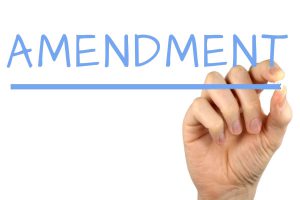Correction and Amendment in a trademark
Correction and amendment:

The registrar on such terms as he thinks at any time, whether before or after the acceptance of an application for registration as under the section 11, correction of any error will be permitted or in connection with the application or permit the amendment of the application:
If an amendment is made to a single application which has been referred in sub-section (3) of section 11 involving the division of such application into two or more applications, the date of making the initial application may be deemed to be the date of making of the divided application so divided.
Section 15 empowers the registrar to carry out correction of any error and amendments in an application whether before or after acceptance if any errors are found in the application.

An applicant for registration of a geographical indication before the GI is registered may apply on form GI-5 (with the prescribed fee) for the correction of any error in or in connection with his application or any amendment of his application. However, the amendment should not relate to an amendment of the GI or amendment in the description of goods or to the definite territory, region or locality, as the case may be, that would have the effect of substantially altering or substituting the original application.
The proviso to section 15 makes it clear that if an amendment is made to a single application, involving division of such application into two or more applications, the date of the making of the initial application will be deemed to be the date of the divided application also.
The first part of section 15 corresponds to section 22 of the trademarks act, 1999 and provides that the registrar may, on such terms as he thinks just, at any time, whether before or after acceptance of an application for registration under section 11, permit the correction of any error in or in connection with the application or permit an amendment of the application.
What correction or amendment is allowable?

The correction or amendment envisaged under this section may be made at any time after an application is filed and before the registration of the mark. Nevertheless, it is advisable for an applicant to make such correction or amendment, wherever necessary, before the application is accepted and advertised in the journal, to obviate the re-advertisement, entailing a delay in eventual registration of the GI.
The difference between correction and amendment is obvious. The section does not say what corrections or amendments are allowable. It does not say or lay down precisely the nature of corrections admissible.
The corrections should be such as do not substantially affect the identity of the GI or extend the goods covered by the application. Obviously, therefore, the amendment of GI, when sought to be made can only involve minor changes of the above nature.
The practice of Indian trademarks registry:
The Indian registry’s practice under the trademarks act has been also more or less on the same lines as in the U.K., in so far as allowing corrections of any error in or in connection with the application. Corrections may be of obvious mistakes, errors, and mistakes in typing including in the names or address of the applicant. The GI act in India, however, is not so rigid as in U.K, in this respect (under the current U.K. Act of 1994), but continues to be what it was under the trade and merchandise marks act, 1958 act, and therefore the same old practice would continue, in respect of amendment.
The expression amendment would imply something more than correction. For example, if the applicant wants to replace a label GI with a GI limited to the distinctive element consisting of a word per se, the GI registry may not find it objectionable and allow such an amendment, requiring the applicant to submit fresh representations, confining the GI to the word per se, following the practice of the TM registry in this respect. Where a label is in color and is sought to be registered without limitation to colors, and is required or proposed to be amended by deleting some non-distinctive matter, the applicant is permitted to substitute a label of black and white, with the required number of representations. The applicant may either choose to file black and white fresh representations for substitution, where the original label was in color, or submit fresh colored representation.
If a label contains letter R in a circle, or the word REGD/REGISTERED, the registrar might require the deletion of such sign and submit fresh representations without such sign or expression, instead of altogether refusing the application for misrepresentation of the GI as registered, when it is not so registered, which according to section 42 is a punishable offence.
Under the trademarks law, if a mark is only proposed to be used on the date of the application and to overcome the registrar’s objection on ground of distinctiveness, the applicant may desire to amend the mark and the registrar may permit such an amendment before advertisement of the mark, so as to obviate the difficulty for the applicant to file a fresh application and wait for years for the same to mature for processing. Such a situation will not arise in the case of a GI, where it is a prerequisite for the GI to serve to designate the origin of the concerned goods. In any case, once the GI is advertised, the position becomes different and no such amendment will be allowed as being a substantial alteration. It has been held that on the question whether an amendment of a mark would substantially affect the identity of the mark, it is a matter of discretion for the registrar to decide.
Amendment – Registrar’s jurisdiction after a mark is opposed:
If an applicant wants to amend his mark in the light of an opposition, it is no longer a matter between the registrar and the applicant alone. Indeed, the question is not only between the rights of the two parties before him, but also the interest of other traders who may like to oppose the proposed amended version of the label. It has been held that once an opposition is entered, the registrar has no jurisdiction to decide that the registration shall be allowed, upon a modification of the mark.
Notification or re-advertisement:
Sub-section (2) of section 13 gives discretionary power to registrar either to notify or re-advertise the correction or amendment in the application where an error in the application has been corrected or the application has been permitted to be amended under section 15 after the advertisement.
Though it is a matter of discretion, any amendment which affects the representation of the GI, or the goods covered by the application would, in general, be re-advertised, as such amendments are likely to affect third parties rights. On the other hand, correction of obvious mistakes or errors after advertisement will be merely notified.
Where there is a re-advertisement of an application, the provisions of section 21 will apply. In the case of notification of corrections, however, section 21 has no application.
Division of application:
The proviso to section 15 provides that if an amendment is made to a single application referred to in sub-section (3) of section 11 involving division of such application into two or more applications, the date of making of the initial application shall be deemed to be the date of making of the trademarks law treaty, so as to permit the filing of a single application for registration of a GI in several classes.
Section 11(3) enables a single application to be made for registration of a GI for different classes of goods. When a single application is made for registration of a GI in several classes and if the registrar raises objection in respect of the GI in respect of one or more classes, the applicant may seek to divide the application so as to enable the GI to proceed further for advertisement in respect of the classes which are free from objections. A similar situation may arise after the GI is advertised and when an opposition is filed. The opponent may have an objection to registration of the GI in some classes, while he has no interest in respect of others in the same application. The division of application may thus become possible:
- As a result of examination by a registrar and before advertisement; or
- During any opposition proceedings; or
- During any appeal proceedings against the decision on the registration of the GI.
The law relating to a division which is primarily intended to facilitate the processing of the application and not to tie it down along with other goods in respect of which objections have been raised will be administered by the registrar to the advantage of the applicant. In such cases, where on request of the applicant, the application is divided, the divided application shall preserve the same filing date as of the original or initial application in terms of priority right. The proviso to section 15 makes explicit provision in this regard.

